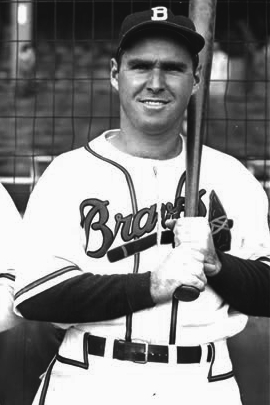Tommy Holmes’s Sensational Summer of 1945
July 27, 2014 by Scott Ferkovich · 2 Comments
 During World War 2, baseball’s talent level was at an all-time low. Rosters were depleted as players headed off to do their duty for Uncle Sam. Hall of Famers had large chunks of their prime years wiped out, including Hank Greenberg, Bob Feller, Ted Williams, and Joe DiMaggio. Major League Baseball made the best of a bad situation, trotting out retreads, castoffs, and career minor leaguers to round out squads.
During World War 2, baseball’s talent level was at an all-time low. Rosters were depleted as players headed off to do their duty for Uncle Sam. Hall of Famers had large chunks of their prime years wiped out, including Hank Greenberg, Bob Feller, Ted Williams, and Joe DiMaggio. Major League Baseball made the best of a bad situation, trotting out retreads, castoffs, and career minor leaguers to round out squads.
For Tommy Holmes, an untreatable sinus condition exempted him from being drafted. A Brooklyn kid, he turned 25 years old just before his rookie season with the old Boston Braves in 1942. He had originally signed as an outfielder with the Yankees in 1937. Despite stellar seasons in the minors, he was unable to break into a New York outfield that featured Joe DiMaggio, Tommy Henrich, and Charlie Keller. Yankee general manager George Weiss dealt Holmes to Boston, where he quickly became one of the most popular players ever to call Braves Field home.
Paul Waner was a teammate of Holmes on the Braves. Holmes got some hitting advice from the future Hall of Famer that he never forgot. “He used to tell me, ‘look, there are three men in the outfield. Why should we hit it where they are?’ He used to preach shooting for the foul lines. If you missed, he said, it was just a foul ball; if you got it in, it was a double. ‘And if it goes in the stands,’ he said, ‘don’t worry. We don’t pay for the baseballs.’ If they tried to cover the lines on him, then they were opening gaps in right- and left-center and he would put the ball out there. This is what he taught me. And while I wasn’t a power hitter, I used to get around 35 or forty doubles a year, from following Paul’s advice.”
From 1942 to 1948, Holmes averaged 42 doubles. A lifetime .302 hitter over eleven seasons (all but one with the Braves), Holmes’s was at his best in 1945. “Everything I tried, everything I did, worked out.” He led the majors in hits (224), doubles (47), home runs (28), total bases (367), slugging percentage (.577), and OPS (997). He scored 125 runs and drove in 117. He even stole 15 bases. The Chicago Cubs’ Phil Cavarretta narrowly edged him out for the batting title, at .355 to .352. Incredibly, Holmes struck out only nine times all season.
Holmes hit .408 in his home park that year. His hottest month was June, when he batted .390. On the 6th, in the first game of a doubleheader, he began a 37-game hitting streak, breaking Rogers Hornsby’s modern-day National League record of 33. Holmes finally went hitless in the first game of a July 12th doubleheader, against the Cubs at Wrigley Field. He pointed out, “It wasn’t until after I’d broken the record that I realized how much tension and pressure I’d been under. A sigh of relief went out of me so huge that I felt like a collapsing balloon. Up until that moment it had never bothered me; but, boy, it had been building.”
During the record-setting 37-game hit streak, Holmes batted .423 with nine homers and 41 RBIs, and an OPS of 1.193. His National League mark stood until 1978, when Pete Rose broke it, eventually establishing a new N.L. benchmark of 44.
The Braves finished a pedestrian 67-85 in 1945. Strangely, Holmes finished second in the MVP voting to Cavarretta, whose Cubs won the National League pennant that year. Except for batting average, Cavarretta’s numbers paled in comparison to Holmes in every offensive category.
War year or not, and MVP or not, Holmes’s 1945 season was extraordinary.


Nice story about Holmes, but the NL record he broke was Willie Keeler’s 44 straight in 1897.
It’s not likely that the talent level was at an all-time low during WW2. Research has indicated it dropped only about 10% during 1943-45. In fact, according to Richard Cramer’s classic article ( http://research.sabr.org/journals/average-batting-skill ), the average batting skill in the 1945 NL was equivalent to that in the 1935 NL. So, no need to downgrade Holmes’ fine season that much.
(Also, Keeler had a 45-game hitting streak including the final game of the 1896 season. There’s no reason to think a consecutive game hitting streak ends when the season does any more than a consecutive game playing streak does.)